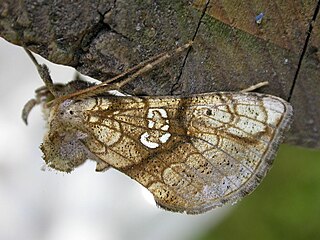Related Research Articles

The red underwing is a moth of the family Erebidae. The species was first described by Carl Linnaeus in his 1767 12th edition of Systema Naturae.

Agrochola lychnidis, the beaded chestnut, is a moth of the family Noctuidae. It is distributed throughout the whole of Europe from Ireland to the Urals. It also occurs in western North Africa and Asia minor.

Orthosia incerta, the clouded drab, is a moth of the family Noctuoidea. It is found in Europe. The occurrence of the species extends through all European countries through the Palearctic to the Russian Far East and Japan. It is absent from northern Fennoscandia. In the Alps it occurs up to 2000 m above sea level.

Mormo maura, the old lady or black underwing, is a moth of the family Noctuidae. The species was first described by Carl Linnaeus in his 1758 10th edition of Systema Naturae. It is found in the Palearctic ecozone, from north-western Africa through all over southern Europe. It reaches its northern border in the west in northern Ireland and central Scotland, in central Europe, in northern Germany and Poland. In some Nordic countries, there are single finds. The other occurrence areas include Turkestan, Anatolia, the Middle East and Iraq. The name "old lady" refers to the fact that the wing pattern was said to resemble the shawls worn by elderly Victorian ladies.

Helotropha leucostigma, the crescent, formerly Celaena leucostigma is a moth of the family Noctuidae. It is found in the Palearctic ecozone

Polychrysia moneta, the golden plusia, is a moth of the family Noctuidae. It is found in the Palearctic ecozone.

The gold spangle is a moth of the family Noctuidae. The species was first described by Michael Denis and Ignaz Schiffermüller in 1775. It is found in Europe, across western Siberia and the Altai Mountains, the northern Caucasus, northern Turkey and northern Iran.

Mesapamea secalis, the common rustic, is a moth of the family Noctuidae. The species was first described by Carl Linnaeus in his 1758 10th edition of Systema Naturae. It is found in Europe, north-west Africa, Turkey and northern Iran.

Grammodes stolida, the geometrician, is a moth of the family Erebidae. The species was first described by Johan Christian Fabricius in 1775. It is found in Africa, southern Europe, most of Asia and Australia. It migrates to central and northern Europe as far north as England, Denmark and Finland.

Nycteola revayana, the oak nycteoline, is a moth of the family Nolidae. The species was first described by Giovanni Antonio Scopoli in 1772. It is found from Europe and east across the Palearctic to Japan and India.

Oraesia emarginata is a species of moth of the family Erebidae first described by Johan Christian Fabricius in 1794. It is found in Australia, New Caledonia, Indonesia, New Guinea, Pakistan, the Philippines, India, Sri Lanka, Sulawesi, Taiwan, China, Japan, Korea and Nepal as well as Eritrea, Ethiopia, Kenya, Namibia, Nigeria, South Africa, Tanzania, the Gambia, Uganda, Oman and Yemen.
Auzata ocellata is a moth in the family Drepanidae. It was described by Warren in 1896. It is found in northern India, northern Myanmar and Fujian in China.
Euphalacra nigridorsata is a moth in the family Drepanidae. It was described by Warren in 1897. It is found in the north-eastern Himalayas.
Epipsestis castaneata is a moth in the family Drepanidae. It was described by Warren in 1915. It is found in Sikkim in India, Hunan in China and in Nepal and Vietnam.
Habrona concinna is a moth in the family Drepanidae. It is found in Papua and Papua New Guinea, where it has been recorded from mountainous areas.
Habrona marmorata is a moth in the family Drepanidae. It is widely distributed in Papua and Papua New Guinea.
Habrona papuata is a moth in the family Drepanidae. It is found in Papua and Papua New Guinea, where it has been recorded from mountainous areas.
Nothoploca nigripunctata is a moth in the family Drepanidae. It is found in India, Vietnam, Korea, China and the Russian Far East.
Takapsestis semiobsoleta is a moth in the family Drepanidae. It is found in Indonesia.

Wernya rufifasciata is a moth in the family Drepanidae. It was described by Yoshimoto in 1987. It is found in Taiwan.
References
- ↑ Beccaloni, G.; Scoble, M.; Kitching, I.; Simonsen, T.; Robinson, G.; Pitkin, B.; Hine, A.; Lyal, C., eds. (2003). "Habrona caerulescens". The Global Lepidoptera Names Index . Natural History Museum . Retrieved May 25, 2018.
- ↑ The False Owlet Moths (Drepanidae, Thyatirinae) of Papua Indonesia
- ↑ Some new oriental Cymatophoridae in the Tring museum
| This article on a moth of the subfamily Thyatirinae is a stub. You can help Wikipedia by expanding it. |